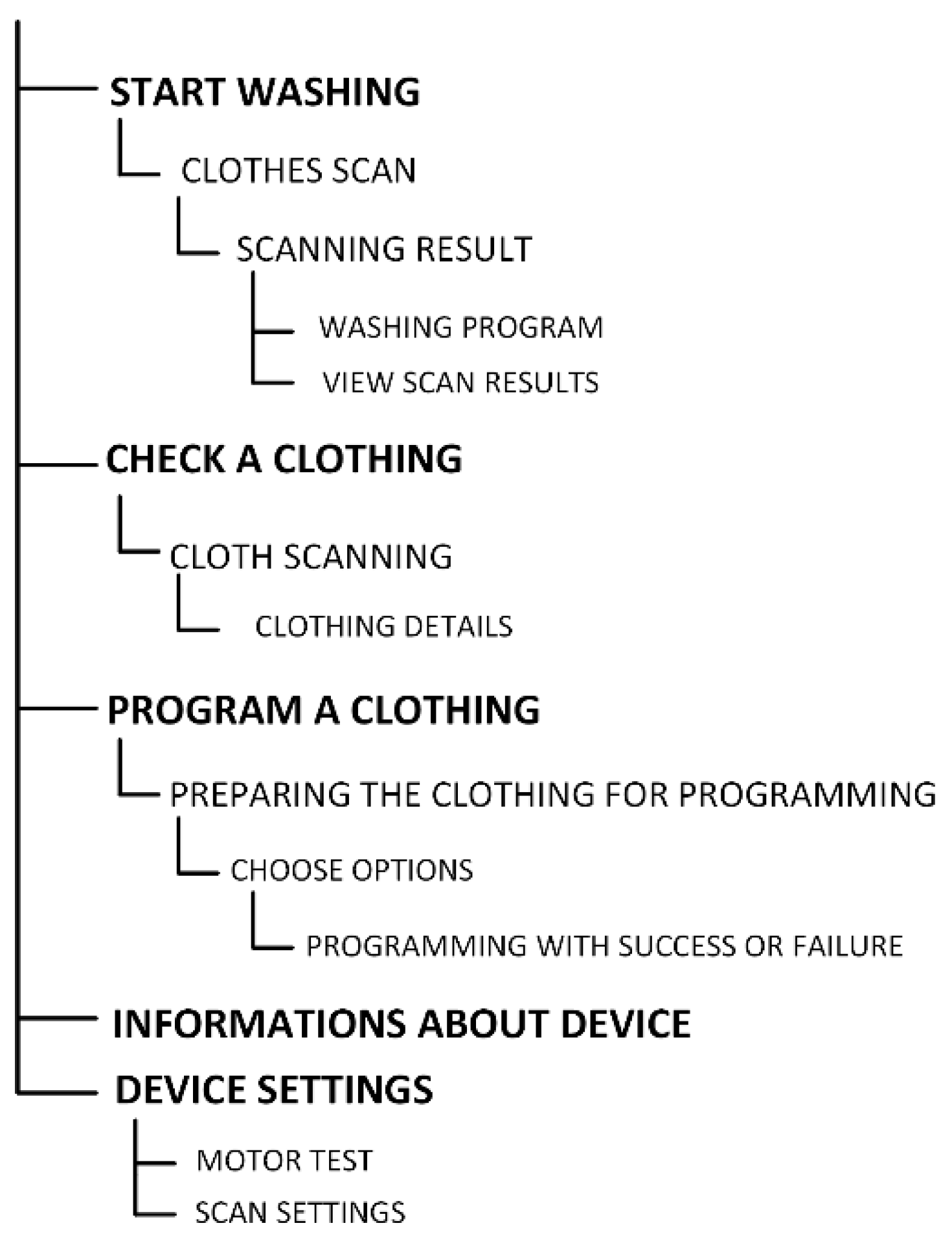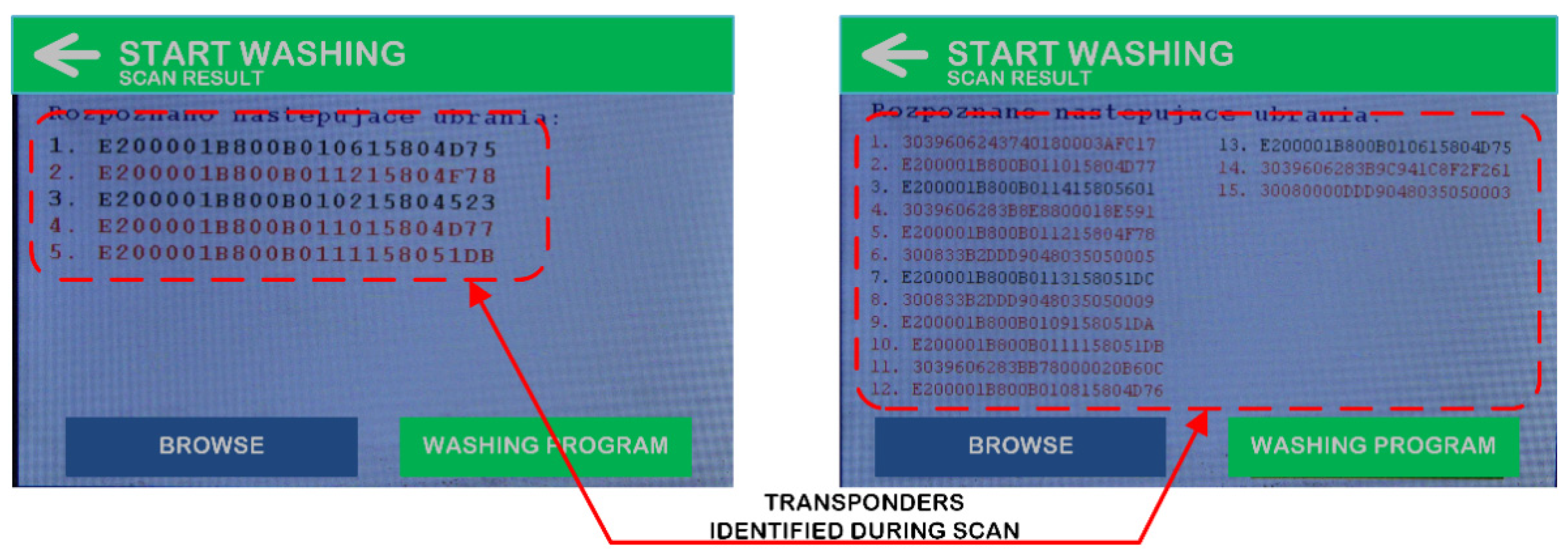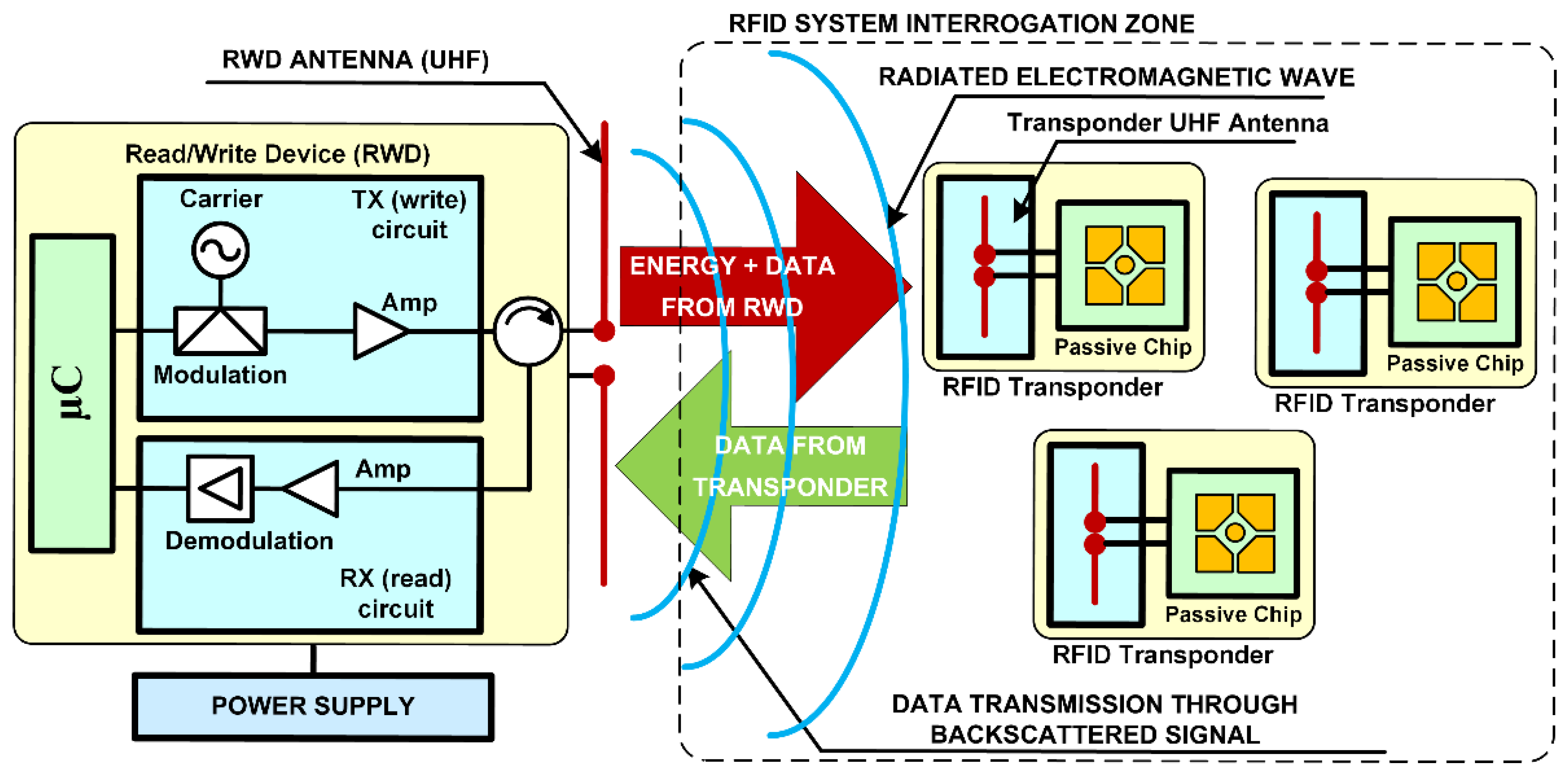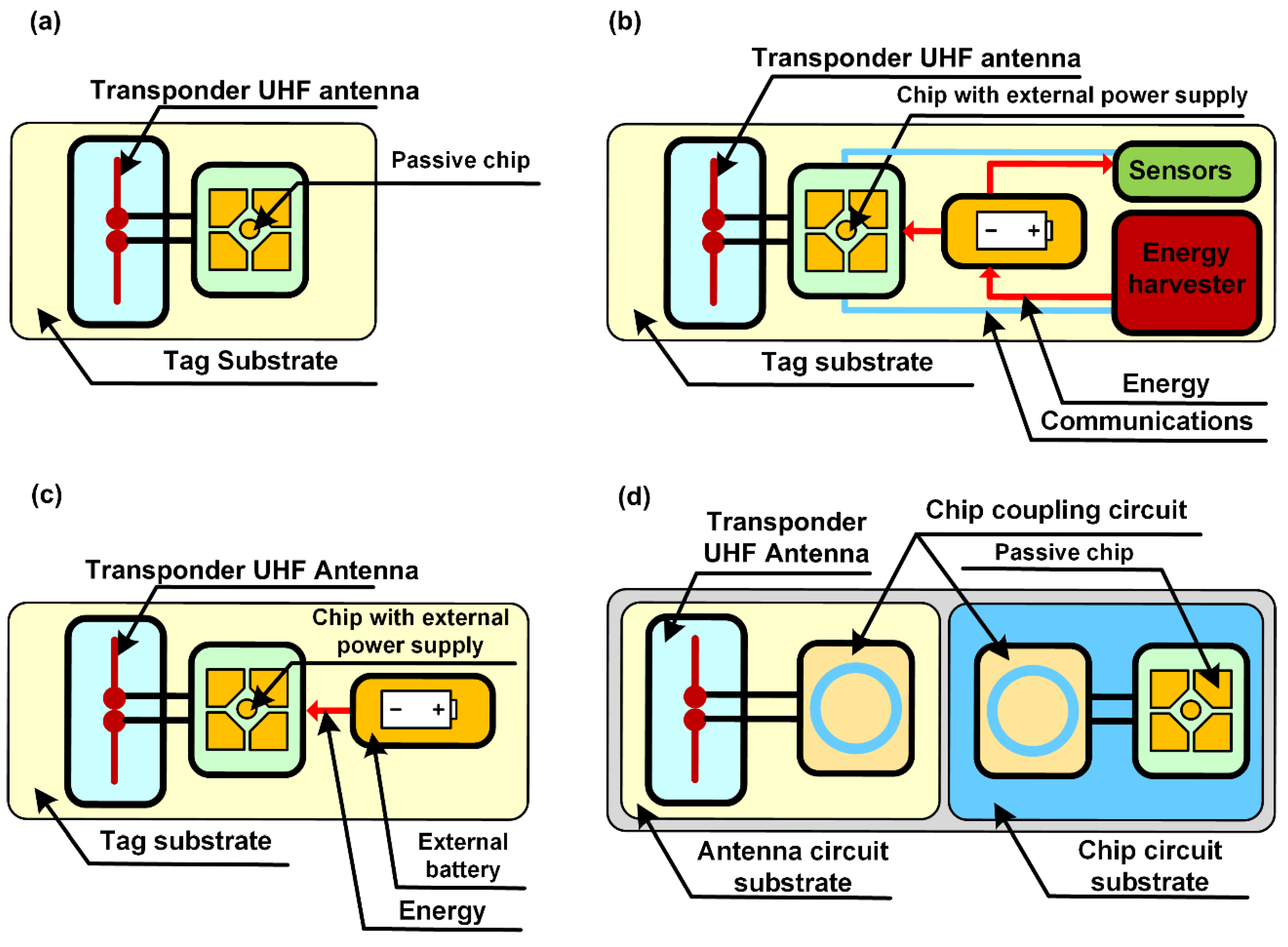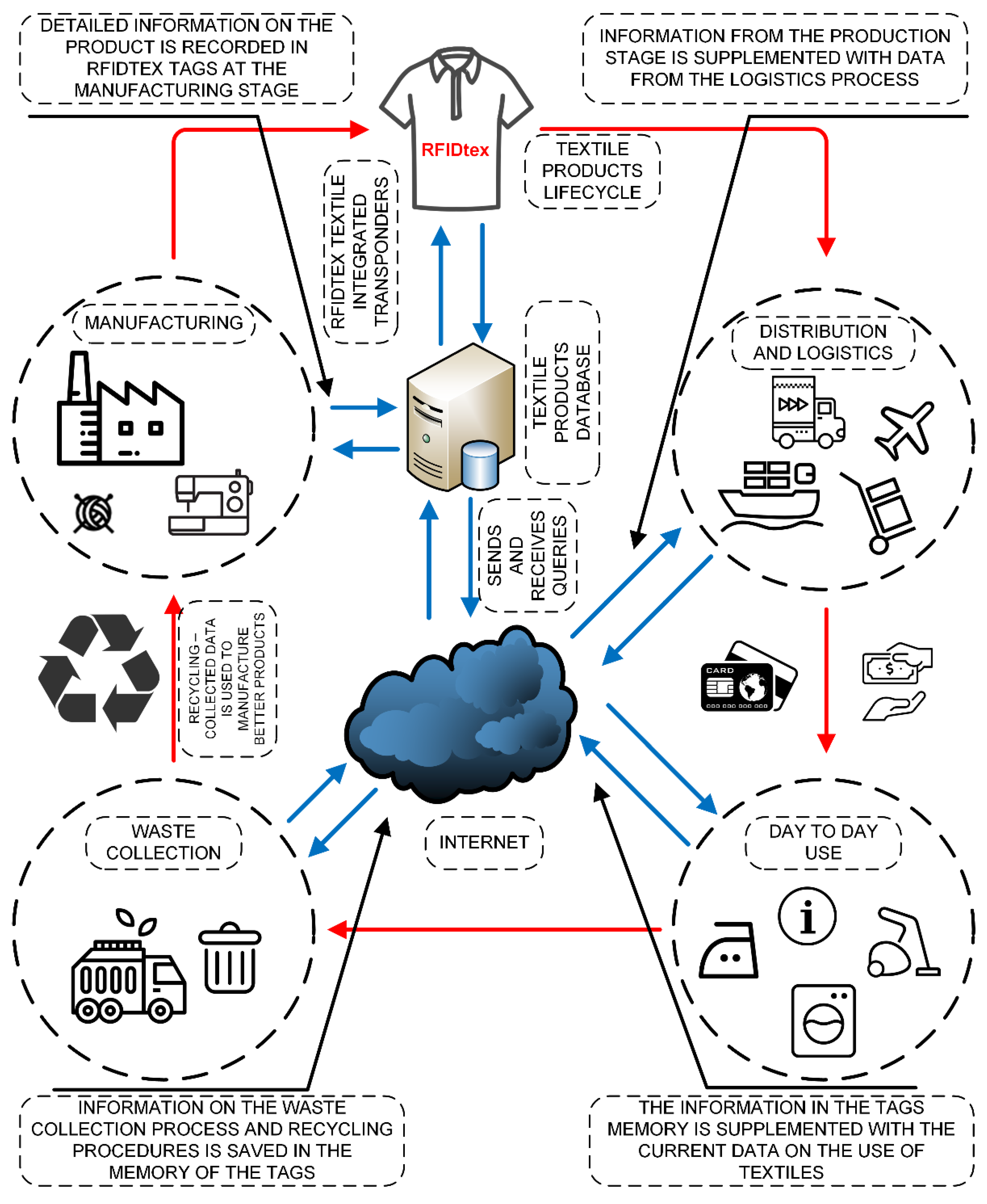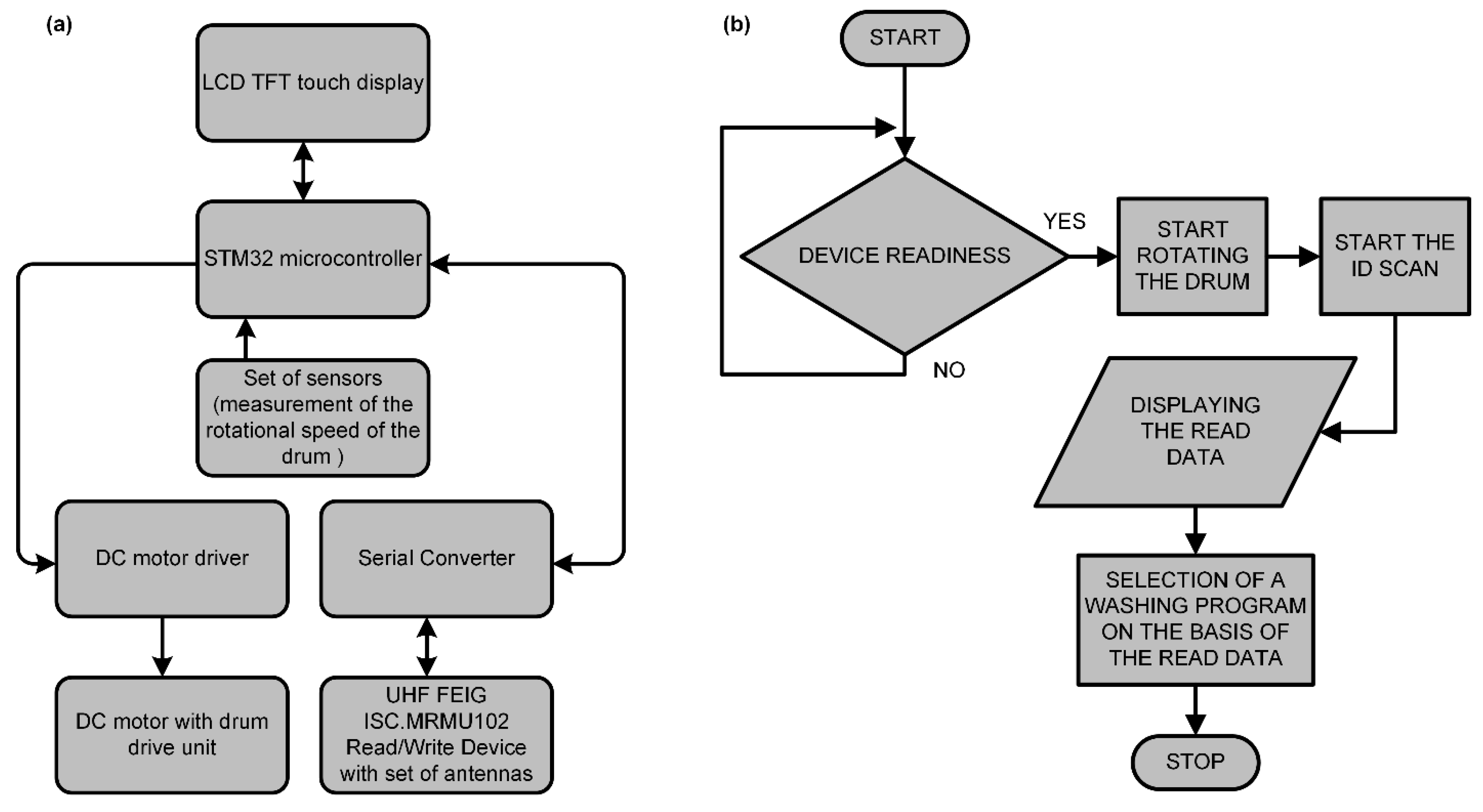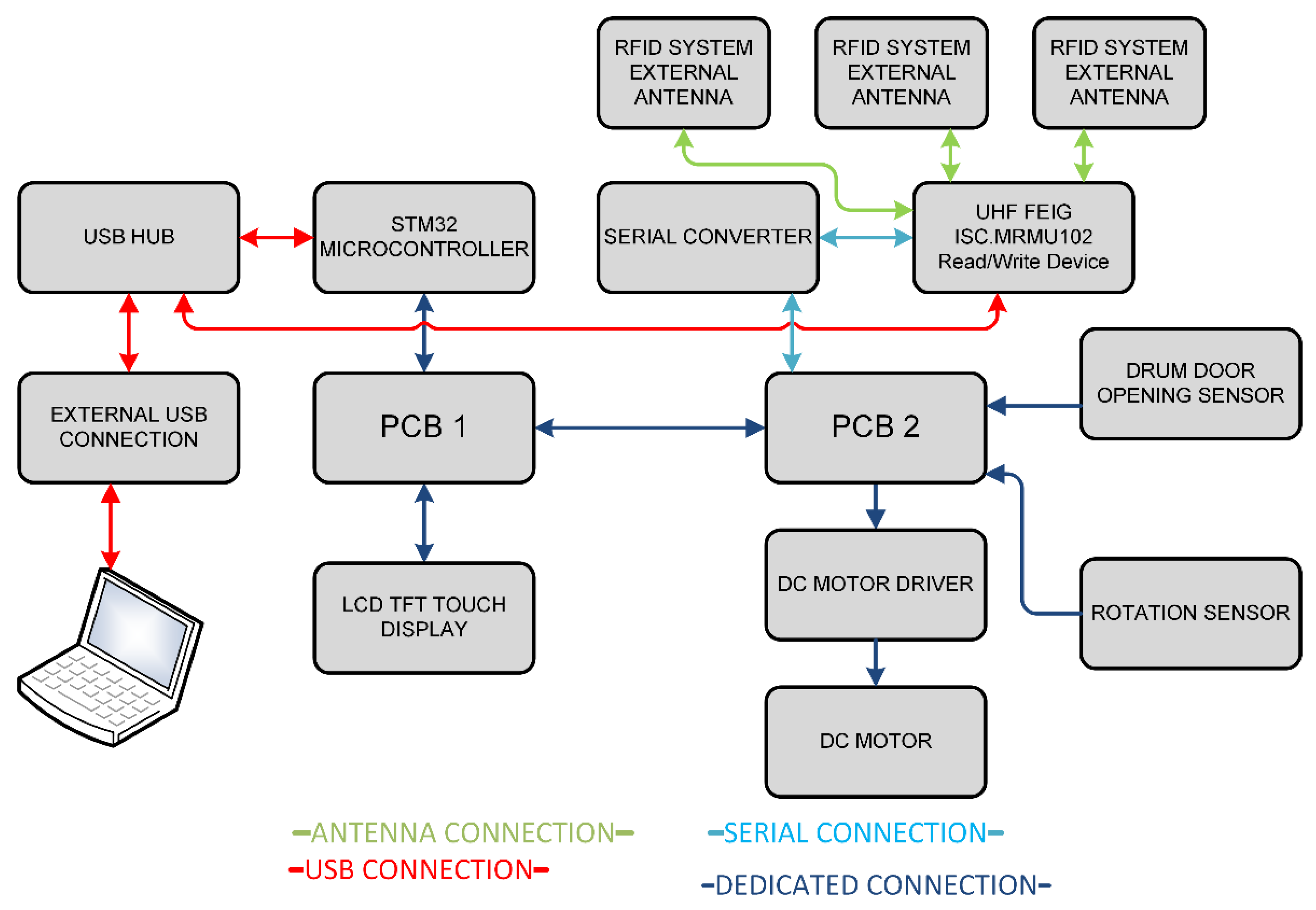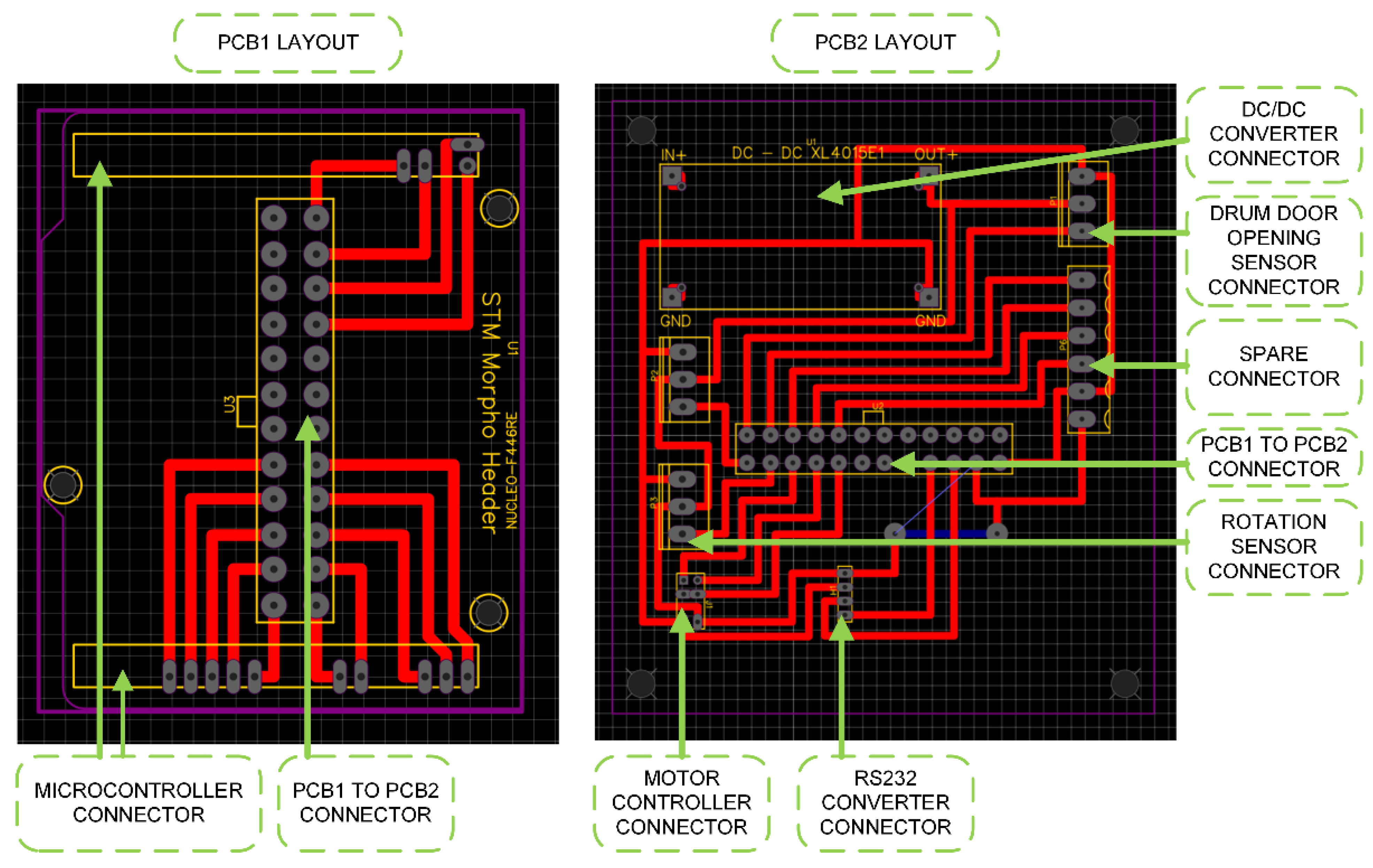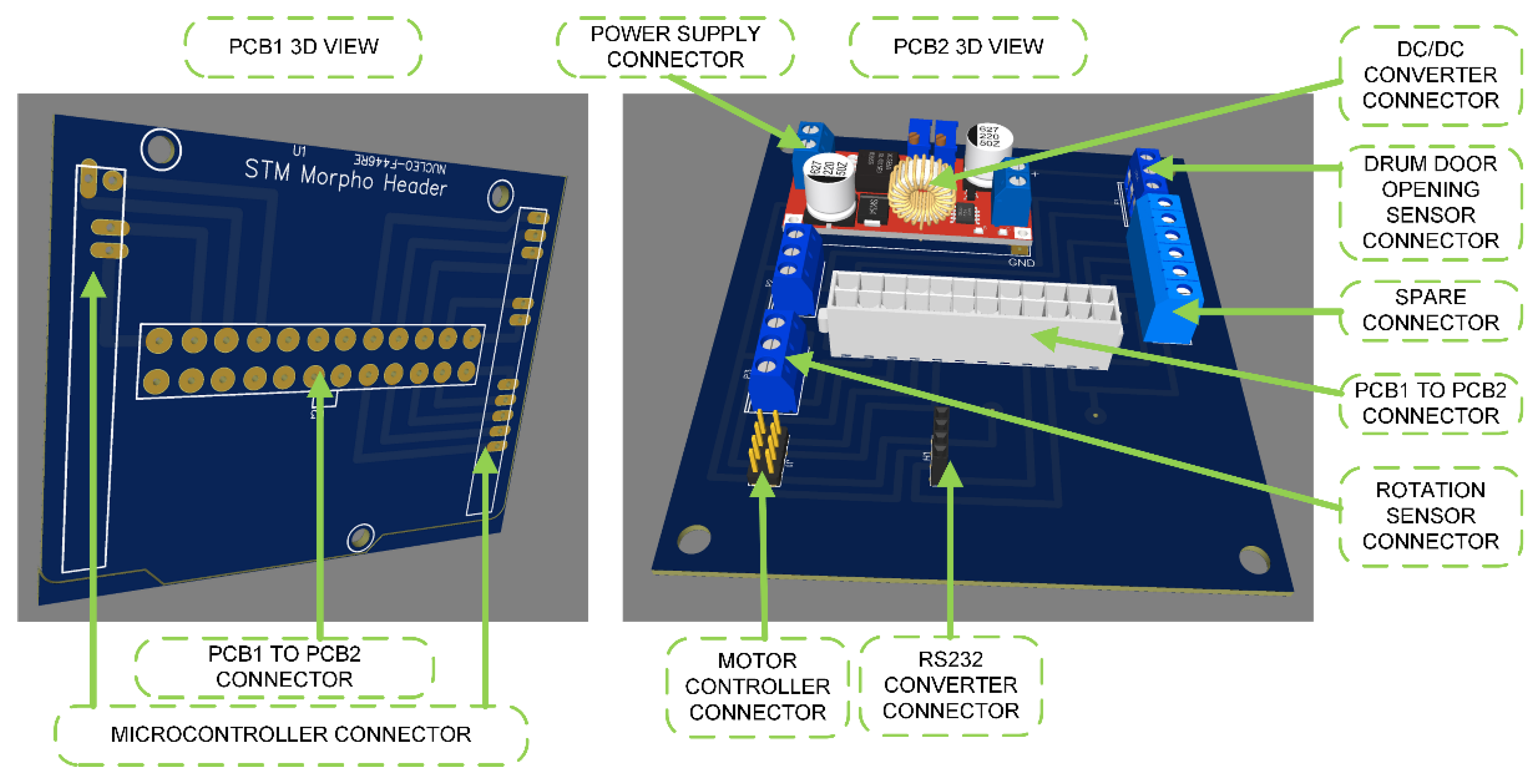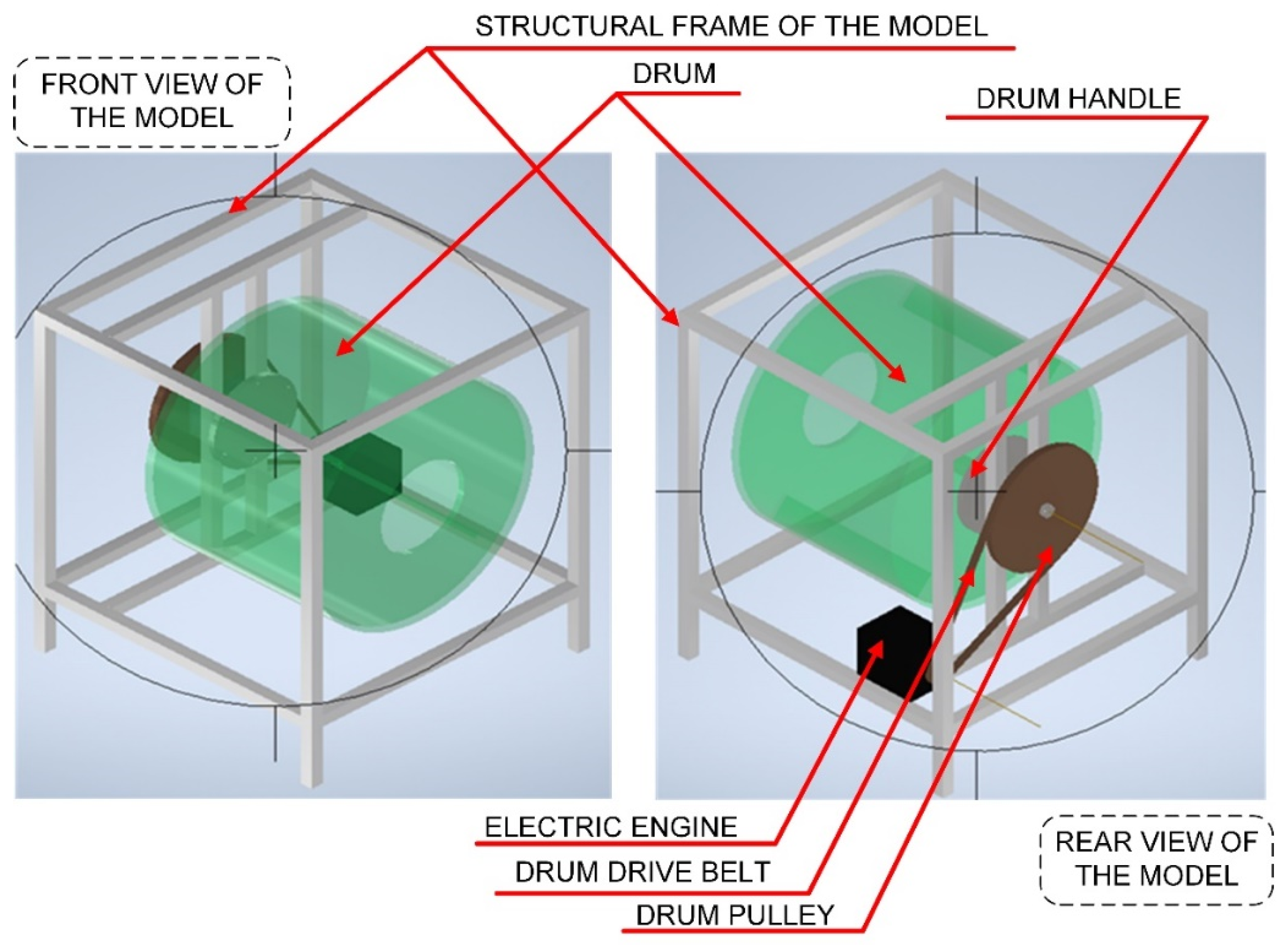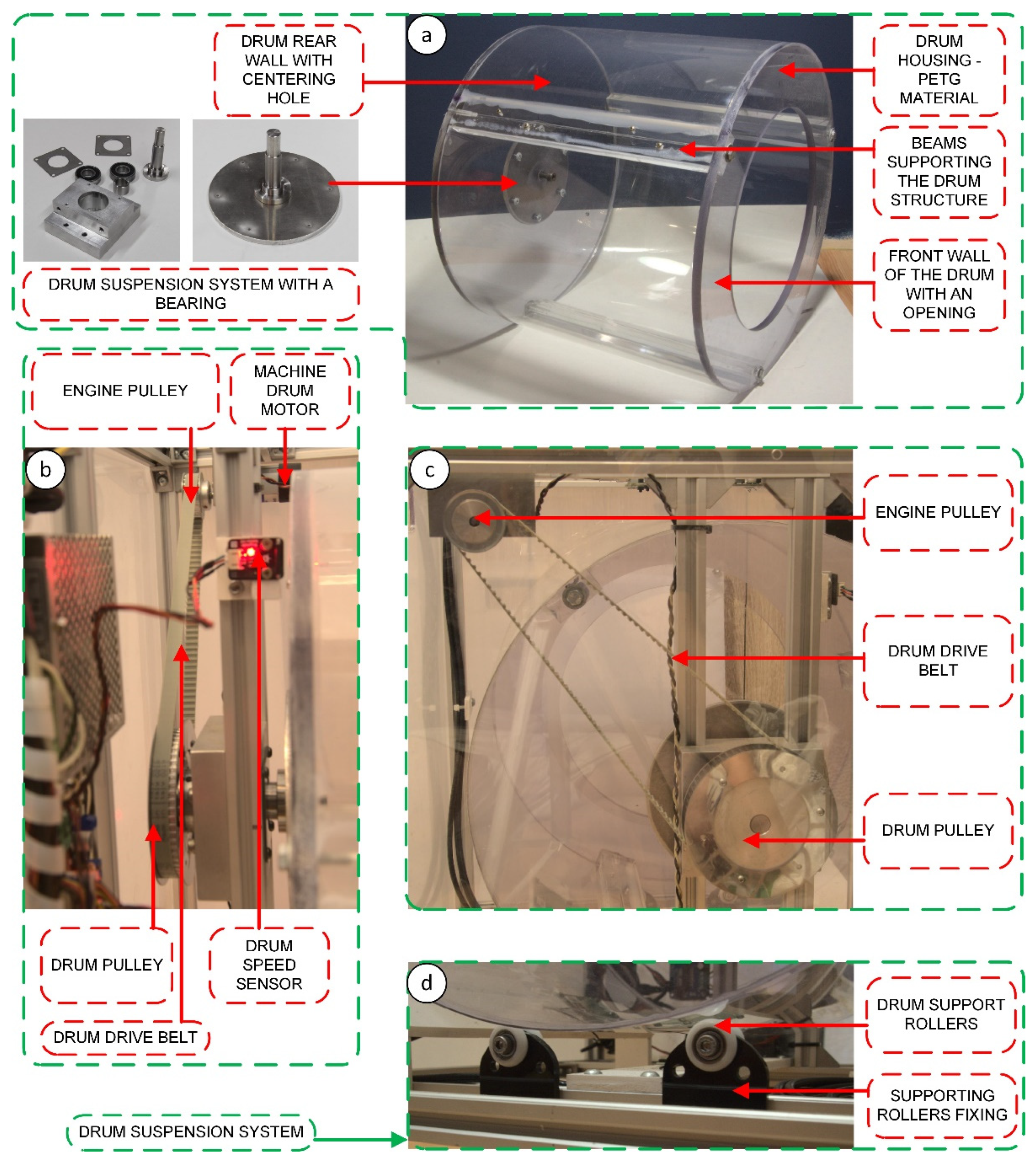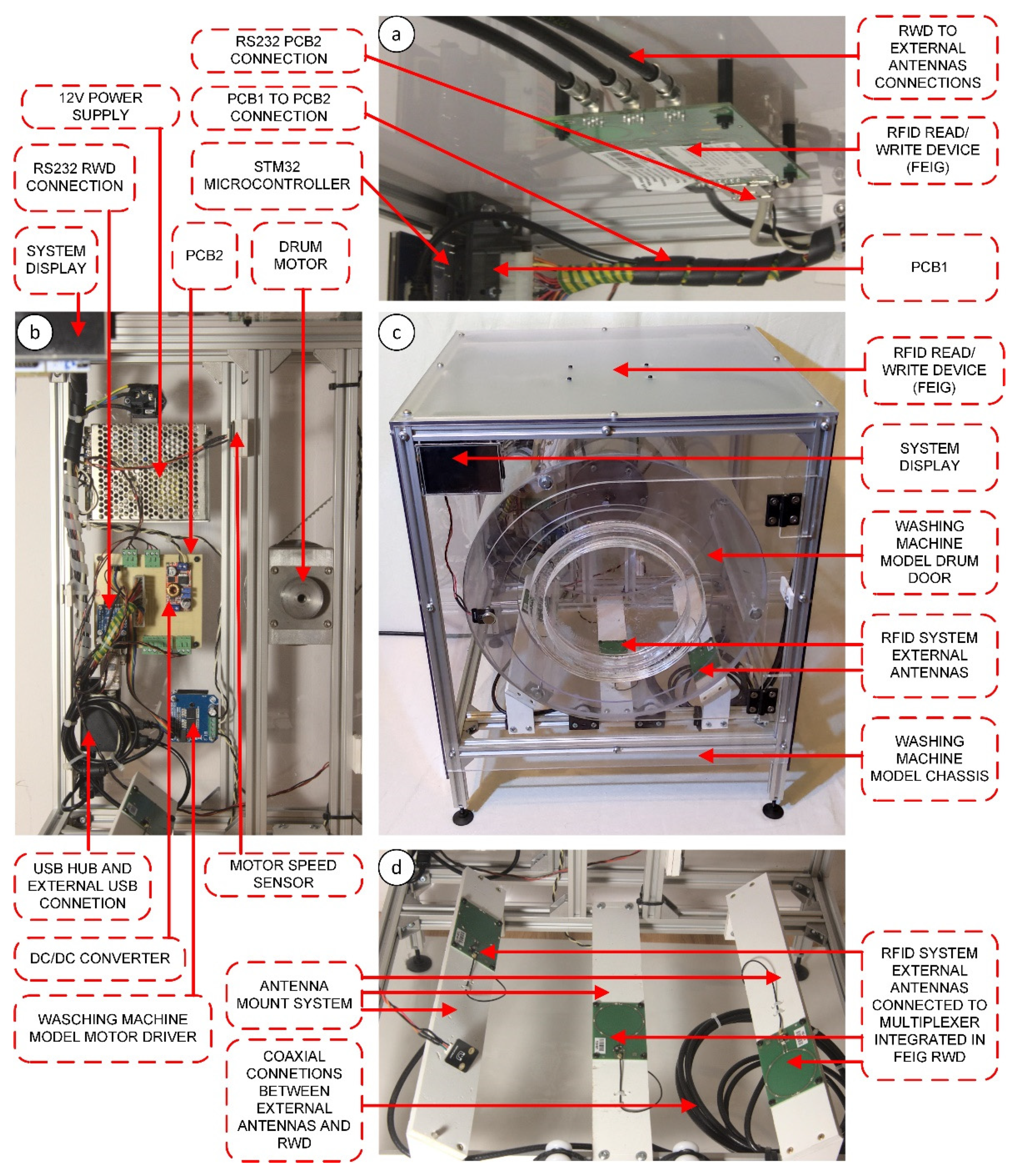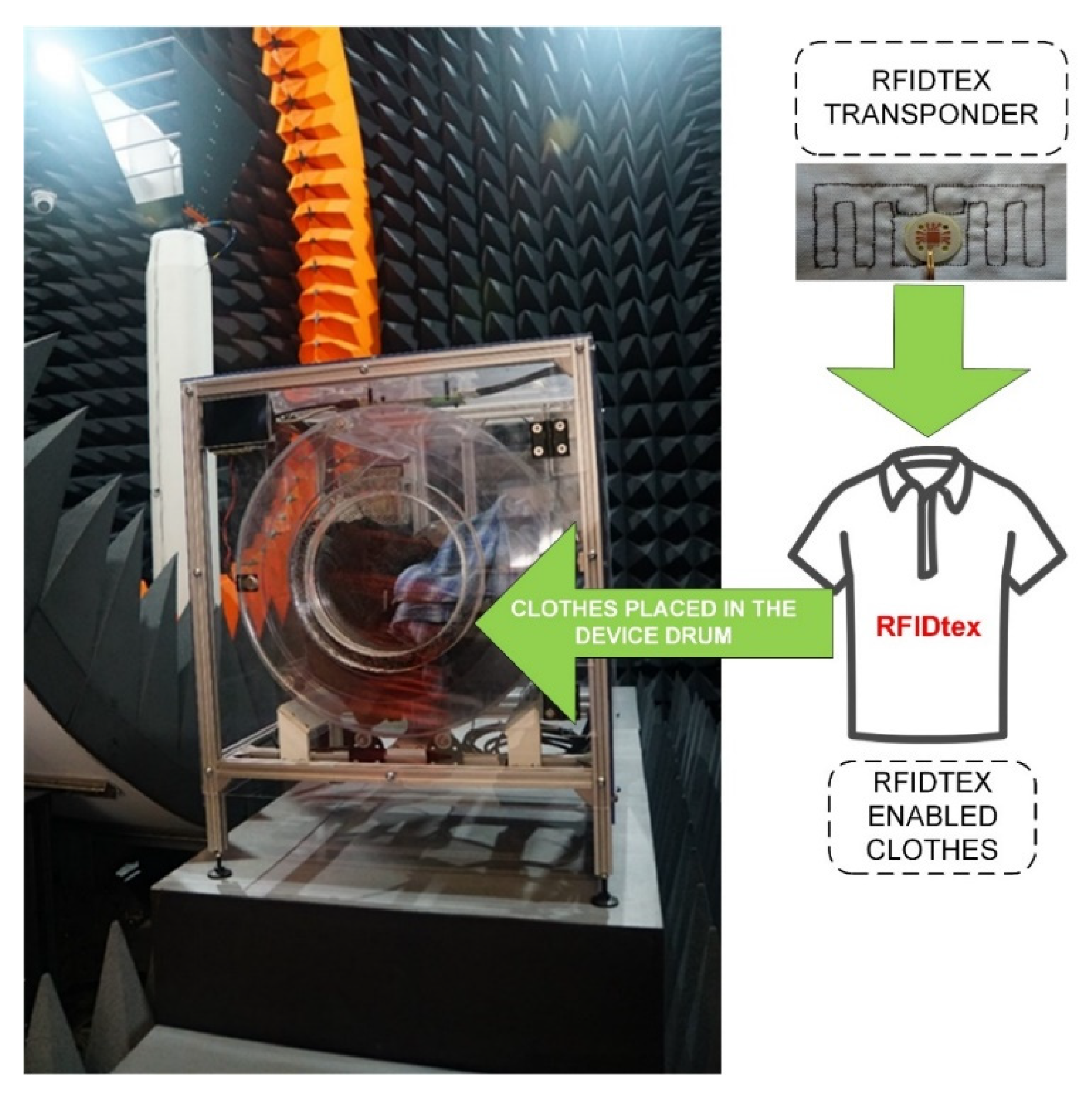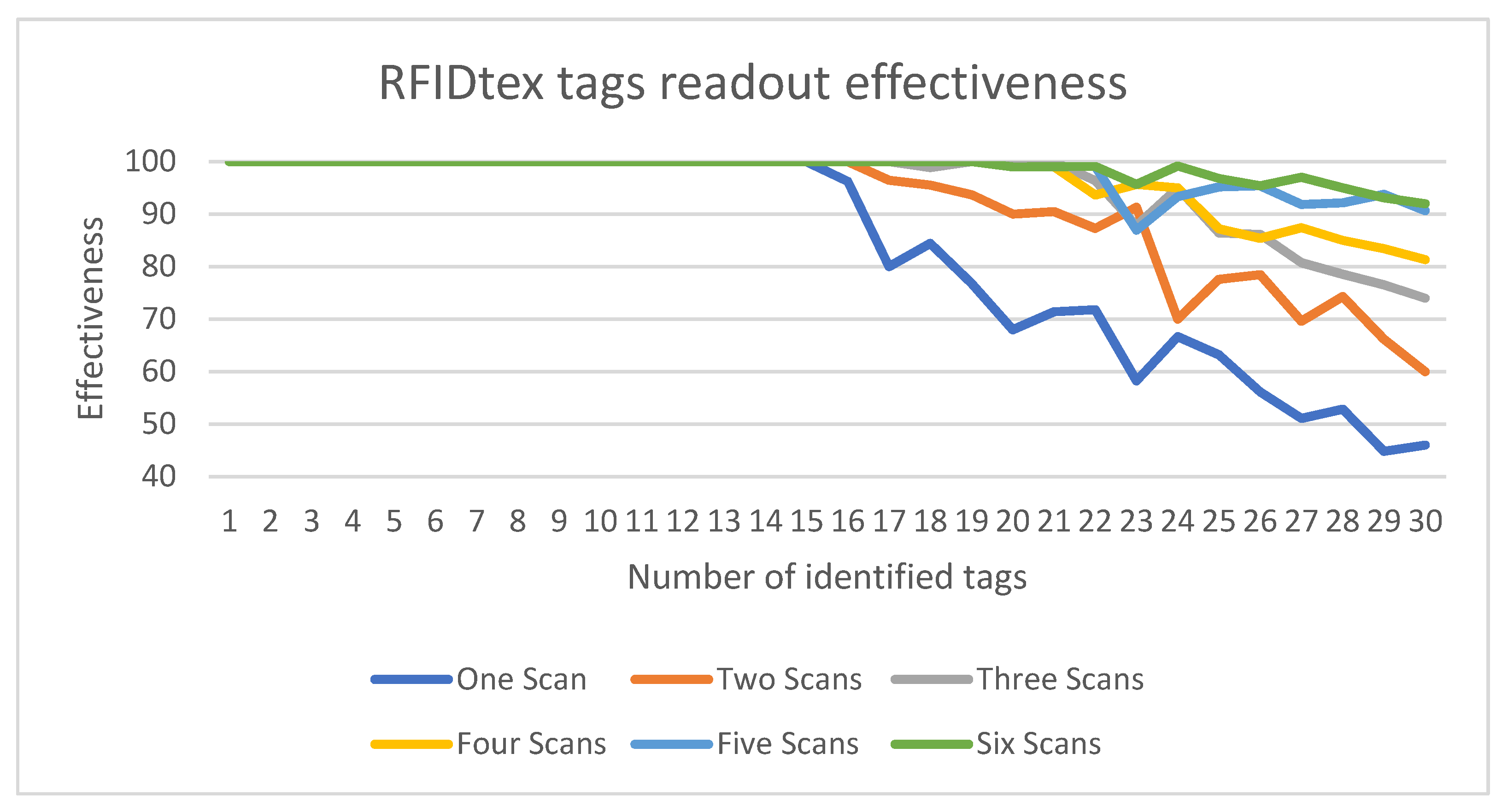1. Introduction
It is human nature to look for ways to make everyday life easier. One of the activities people have been looking to automate is washing clothes. The first washing machine working with usage of a rotating drum was patented in 1858 by H. Smith. In 1874, a washing machine designed by W. Blackstone came into use in households. Originally, the device was built as a gift for a wife [
1].
The development of an electric drive at the edge of the 20th century enabled the construction of washing machines with a drum moved by an electric drive [
2,
3,
4]. However, the principle of washing, which includes the process of movement of clothes in water with detergent for a certain period of time, has not changed [
5,
6,
7]. The design of the washing machine has only been modernized and modified [
8,
9,
10,
11,
12,
13]. Microcontrollers have been added to washing machines, allowing controlled dosing of detergents, water, regulation of water temperature, and drum rotation speed [
14]. It does not change the fact that it is the user who still has to decide which clothes should be placed in the drum for a single wash cycle and determine the washing temperature and the drum rotation speed. The user must also choose the detergent that is most appropriate for the bundle of textiles in the drum and the appropriate amount of it. Incorrect settings selection can damage textiles in the washing machine drum.
The solution to these problems seems to be the use of systems in washing technology devices that allow precise information about the fabrics loaded into the drum to be obtained, and on this basis, determine all the settings of the washing program by the algorithm of the microcontroller built into the device. To make this possible, it is necessary to equip clothes with information carriers in the memory in which the precise parameters of washing the fabric can be saved at the stage of its production. One of the potential carriers of this type of information may be the RFIDtex textronic transponder developed as part of the research carried out at the Rzeszów University of Technology [
15]. The use of such transponders creates completely new possibilities in the scope of the fabric washing process.
The use of RFID systems in household appliances can create a completely new approach to automatic washing. Human involvement in selecting a washing program can be kept to a minimum. Characteristics of water temperature in individual stages of washing as well as the type, amount, and time of detergent dosing in addition to the rotation of the drum during washing are determined fully automatically on the basis of information read from RFID transponders placed in fabrics. Additionally, connecting this type of device to the Internet makes it possible to update washing programs to adapt them to new types of fabrics. This approach can extend the life of the device and optimize the use of electricity, water, and detergents, making the washing machine more environmentally friendly.
Unfortunately, the washing machines that use RFID systems are not available on the consumer market. Only existing studies are those on the impact of the washing process on RFID textile transponders in standard washing machines [
16,
17,
18,
19,
20,
21]. As a result, it is not possible to test the operation of the experimental RFIDtex transponders under conditions similar to those of the real ones. Hence, there is a need to build a model of an automatic washing machine that allows laboratory tests and tests of the effectiveness of reading data from textronic transponders integrated with fabrics. Only in the case of ensuring high efficiency of identification and carrying out a comprehensive reading of information from the memory of transponders embedded in fabrics, it is possible to implement the above-mentioned functionalities in the future.
The developed model enabled simulation of the first phase of washing fabrics, which means placing fabrics with sewn transponders in the drum and controlling the drum in such a way that it is possible to read information about textiles inside it. In addition, the model control program should suggest the best washing program for the fabrics placed in the drum. This study describes the mechanical, electrical, and electronic structure of the laboratory model as well as preliminary tests of the effectiveness of identifying fabrics with integrated RFIDtex transponders. Procedures related to transponder reading algorithms, the communication protocol model, and the selection of an appropriate washing program remain the subject of a separate study.
2. Principles of the RFID System
Usually, a radio frequency identification (RFID) system consists of an RWD (read/write device) equipped with at least one antenna and at least one transponder that includes antenna circuit, microprocessor, and memory in its structure (
Figure 1). The serial number of the transponder and the data about the identified object are usually stored in its integrated memory. The read/write device reads data from the memory of the RFID transponder. The read data are most often forwarded to the host hardware and software. The second most important function of the read/write device may also be to write data to the memory of the transponder, if necessary.
This allows for updating the contents of the transponder’s memory at various stages of the identified object’s life cycle. The process of data exchange with a transponder takes place only within the interrogation zone (IZ) of the RFID system [
22,
23,
24]. If there is only one object with an RFID transponder in the IZ, the process of object recognition is called single identification. If many objects equipped with transponders are located in the IZ, data exchange with all of them takes place using the anticollision mechanism according to the algorithm defined by the protocol, and it is called multiple identification [
25,
26]. An RFID system in which the location of the RWD antenna with respect to the transponder is constant and the communication time is not limited is called a static system. Therefore, the definition of IZ can be understood as a group of field, electrical, and communication conditions that must be met to gain a certain recognition of a multiple objects tagged with transponders.
In recent research works, the synthesis of IZ comprised experimental studies and analytical and numerical calculations of the range of the RFID system [
22], but in real implementations, the method of trial and error is often used [
27]. In the case in which many objects are present inside the IZ and their position and orientation can change dynamically, the calculation of the parameters of the RFID system is even more demanding due to the parameters describing the dynamics of changes in the system. To systematize the operation of RFID systems, several standards have been developed. The most popular examples are ISO15693 [
28], ISO14443 [
29], and ISO18000 [
30].
3. Types of RFID Transponders
The UHF frequency range was selected because of the possibility of using transponders compatible with the ISO18000-63 standard. The advantage of using this type of transponders is the possibility of identifying many objects at the same time, thanks to the anti-collision protocols provided in the standard.
UHF RFID radio identification systems typically operate in the range of 860 to 960 MHz and also at a selected frequencies of 2.45 and 5 GHz. Choosing the correct value of working frequency depends on the region of the world. On the European continent, RFID systems operate in the 865–870 MHz range according to the protocol specified by ISO/IEC 18000-63 [
31]. There are currently four types of transponders that function in this frequency range: passive, semi-passive, semi-passive with energy harvesting system, and textronic.
The most common RFID passive transponder contains an antenna and a chip (
Figure 2a). Its cases may take various shapes (key rings, cards, labels, glass tubes, discs, or coins) and be made of many materials (ceramic, plastic, metal, glass, etc.). Access to the internal memory of the transponders is possible only through the RWD with the use of radio interface [
32].
Another group of growing importance on the market is semi-passive RFID transponders with an integrated additional power supply (e.g., a removable or non-removable lithium battery) (
Figure 2c). In general, extra battery power is used to increase readout range and thus the interrogation zone [
32] but it can also be used to provide additional functions implemented in the transponder structure (
Figure 2b). Additional transponder functions may take various forms such as measurements of physical quantities [
33] (e.g., temperature, pressure, and humidity), storage of collected information in extended memory, or exchange of data via additional radio or cable interfaces [
34,
35,
36].
Regardless of the frequency band, in classical terms, an RFID transponder is a combination of a chip and an antenna [
32]. Most often, such a device is built as a uniform structure in which the chip is soldered [
37], glued [
38], or otherwise [
39] connected to the antenna. In this structure, the transponder antenna is made of conductive materials on a rigid substrate (low-iron laminate [
40], ceramic [
41], etc.) or flexible [
42] (paper [
43], PET [
44], Kapton [
45], etc.). According to the modern concept of automatic RFID identification systems, transponders are attached to objects in various ways, either permanently or temporarily [
32]. This causes transponders to be produced in various shapes. There is no universal transponder design to mark any object. In each case of RFID system development, the transponder should be selected from ready-made constructions or (which is more advantageous) a solution dedicated to a given object should be designed while taking into account many physical, chemical, electromagnetic field, electrical, and communication conditions of its operation in the target RFID system application [
46,
47,
48,
49,
50,
51].
The latest approach to the design of RFID transponders is shown in
Figure 2d. In this type of construction, the chip and the antenna are placed on physically separated and galvanically isolated bases. The antenna may be embroidered or sewn with conductive threads as well as other techniques, e.g., by pressing a conductive wire that constitutes the antenna into the fabric. The chip-containing module may be manufactured as a blank (e.g., button or label) and integrated into the fabric by sewing it into a marked textile item. The microelectronic module may consist of a typical printed circuit board (PCB or other rigid substrate) to which an RFID chip is attached. The resulting semi-finished product can then be attached to the fabric using techniques used in the textile industry. With this concept (
Figure 2d), the problems of connecting the RFID chip to a flexible and jagged textile substrate can be avoided and thus the semiconductor integrated circuit (IC) can be protected [
52,
53,
54,
55].
4. Internet of Textile Things
The application of RFID systems using RFIDtex transponders integrated with fabrics in household appliances and especially in laundry technology [
56,
57,
58,
59] is perfect for sup porting the Internet of Textile Things (IoTT) ecosystem [
60,
61]. As textronic transponders are intended to be used throughout the lifecycle of a marked textile product, their complete implementation opens completely new possibilities [
62,
63,
64] in terms of production and sale as well as subsequent use and recycling of textiles. The use of RFID systems in laundry technology expands the possibilities of effective management of the life cycle of the IoTT product [
65,
66]. Because RFIDtex transponders are permanently integrated with the product already in the production and quality control stage, their memory can contain detailed data on the parameters of the fabric from which the product is made as well as the performance parameters of the product. In the next steps of the cycle, the data can be supplemented in warehouse inventory systems and can be used for logistic and advertising tasks in the stage of wholesale and retail distribution. Then, as part of the after-sales service, washing machines equipped with RFID identification systems can use the collected information to select the best washing programs for the set of clothes loaded by the user into the drum, the selection of detergents used in the process of washing fabrics, or the amount of water used by the devices (
Figure 3). This approach may influence the optimization of energy consumption of the currently mass-used automatic washing machines. At the last stage, the data collected throughout the product life cycle can be used for the safe treatment of waste.
5. Idea of the RFIDtex-Enabled Washing Machine Model
The main aim of the developed laboratory model of a washing machine was the demonstration character of the use of RFIDtex textronic ISO18000-63 transponders in future modern household appliances and the possibility of conducting identification efficiency measurements in an environment that simulates a washing machine drum. The main task of the constructed device was to read the information from the integrated memory of the transponders sewn into clothing placed in the machine drum. Based on the data readouts from multiple transponders, the system was also designed to assist in making decisions about the appropriate washing program and to display information on the selected program. Additionally, the system was equipped with a transponder programming function using a read/write device and a quick single transponder readout option. These functions are used by the user to independently save additional information in the memory of transponders embedded in clothing.
Figure 4a shows a simplified block diagram of the designed and constructed device. The central element was the STM32 microcontroller which was responsible for receiving, transmitting, and processing data. The microcontroller controlled the operation of the read/write device, display, and the driving unit of the washing machine drum. A touch LCD display was directly connected to the microcontroller. Due to this, the entire device could be managed and the processed data was presented in a user-friendly form. The UHF FEIG read/write device was connected to the microcontroller using the RS232-UART converter. To be able to read the data from the transponders sewn into the clothes placed in the drum of the washing machine model, three external antennas were connected to the read/write device through the multiplexer. The microcontroller controlled the operation of the drive system. The device was also equipped with a set of sensors measuring the rotational speed of the drum to ensure speed stability and a sensor open door sensors to prevent unplanned start-up of the device.
To ensure high identification efficiency in the proposed system (detailed description presented in Chapter 8), it is necessary to optimize the garment scanning process. The accuracy of the data readout from the transponder memory is influenced by many factors including the distance of the transponder from the antenna, external interference, and the number of transponders in the interrogation zone. The concept of the scanning process presented in the simplified block diagram (
Figure 4b) assumes the reading of data from the transponder’s memory during the rotation of the drum, and a separate study will be devoted to the details of the algorithm and the communication model.
6. Electrical Design of the Laboratory Demonstrator
The STM32 Nucleo64 microcontroller controlled the developed laboratory demonstrator. The microcontroller was equipped with a 32-bit ARM Cortex M4 processor that works with 512 KB of flash memory and 128 KB of RAM memory. The system was equipped with a built-in programmer [
67].
Individual components were connected to the microcontroller according to a detailed block diagram on which the directions of information transmission are marked with arrows (
Figure 5). To properly organize the spatial arrangement of the subassemblies in the device, PCB1 and PCB2 boards (
Figure 6) were designed, allowing for the appropriate organization of cabling in the washing machine model housing.
The connection plates were also designed in such a way that multiple components could be easily mounted to the housing of the device. A microcontroller board and a display board were attached to the PCB1 board. The user could issue commands through the display with a touch screen. The display was used the control of the device and also presents information that is relevant to the user, rather than to the device.
Information about detected transponders or reports of errors that occurred while scanning the contents of the drum was presented on the LCD display. The PCB1 board was connected to the PCB2 board with an ATX connector. On the PCB2 board, a DC converter was installed. The PCB2 board was connected to external sensors, motor controller, and the FEIG RFID read/write device (by RS232 converter) through the installed set of connectors (
Figure 7).
Communication took place using a communication bus that was appropriate for each component. To communicate with the FEIG read/write device, it was necessary to use an additional converter of the RS232 signal to the UART signal. To control motor operation, the microcontroller used a DC motor driver that converted the signal from the microcontroller into the PWM signal sent to the motor, which allowed one to change the direction of motor rotation and smooth speed control and which was additionally supported by the reading from the attached magnetic sensor. A sensor of this type was also mounted on the front wall of the device to signal the opening and closing of the door. Individual electronic components were powered by a 12 V built-in DC power supply. The microcontroller, display, and sensors required a 5 V power supply. The voltage conversion was done with the XL4005E1 0.8 V–30 V 5 A step-down converter with voltage regulation and a current limiter permanently installed on the PCB2 board.
The FEIG ID ISC.MRU102 RWD [
68] was used as the device responsible for reading and writing the memory of the transponders. It is a device that operates in the UHF band. Working in this frequency range gives the possibility of reading in the medium and short ranges, cooperating simultaneously with many transponders located in the read/write device interrogation zone. The RWD system was equipped by the manufacturer with communication ports such as RS232 and USB. There was also a built-in antenna on the RWD PCB. It has been adapted to work with both short- and long-range transponders. The RWD was also equipped with three connectors, allowing three additional external antennas to be added. The multiplexer integrated with the RWD was responsible for the operation of these antennas. For the developed device to function properly and effectively, ensuring adequate identification efficiency, dedicated software was developed. Its simplified structure with schematic representation is described in
Appendix A.
7. Mechanical Design
The design of the washing machine model (
Figure 8) equipped with the RFID identification system was made of aluminum v-slot linear rails with a cross section of 20 mm × 20 mm in the form of a rack supporting the drum (which dimensions are comparable to those of a commercial washing machine drum) with the motor and electronic systems necessary for the operation of the model. They were used to make connections between the corner connectors of the profiles fastened with M4 screws with profiles appropriate for the dimensions of the hammer nuts. The use of this type of profiles significantly facilitates the construction of prototype and demonstration devices. The structure prepared in this way allows for trouble-free structural changes that are necessary in the case of subsequent expansion or repair of the constructed device. The use of materials made of aluminum also has a reduction effect on the mass of the constructed device, which, after assembly, enables trouble-free transport. The drum mount was made of a block of aluminum that has been subjected to turning and milling. Two bearings separated by a sleeve were placed in the machined block spacer made of steel (
Figure 9a). The bearing block was attached to a frame made of aluminum profiles. To prevent the bearings from slipping, two rings attached from the outside to the block were cut from the sockets. Inside the bearings, there was a two-part axle (
Figure 9a) to which the drum is attached. The axis of the drum was locked by a gear wheel mounted at its end. Two rings made of an appropriately cut polycarbonate plate were used to build the drum. The front ring had a chute. The rear drum ring had a centering hole. To connect the front and rear rings, three plastic beams were made (
Figure 9a). The material used for the outer layer was a 0.5 mm thick PETG plate, which ensured that the material is flexible enough to fit the shape of the structure and to model the cylindrical shape of the drum. The top layer closing the drum was applied to the structure with the use of glue.
To relieve the rear wall of the drum of the stresses resulting from the one-sided fastening, additional support points were installed. Two double rollers (
Figure 9d) were installed under the drum so that when the drum is heavily loaded, it can lean on them without damaging them. A gear-driven motor was used to drive the drum which was used to obtain a higher torque, facilitating the movement of the drum at low speed. An additional gearbox based on two pulleys and a toothed belt was used to transfer the drive between the engine and the drum (
Figure 9c). Additionally, to secure the belt and prevent its spontaneous fall, securing rings were attached to the gears (
Figure 9b). The use of appropriate gear ratios aimed to level the forces that act on the engine at the moment the drum starts rotating. To ensure smooth adjustment of the motor’s rotation and change of the direction of its operation by means of an appropriate program, it was connected to a microcontroller with an appropriate DC motor driver (
Figure 10b). Transparent polycarbonate plates were attached to the device’s structural frame from the outside. The use of transparent material enabled the observation of internal processes while protecting the internal components of the device against damage. There were openings in the side walls to facilitate the transport of the model. There was a hole in the front wall for the display and a slot to place fabrics with RFIDtex transponders inside the device. A door was attached to the front wall to prevent the badges from falling out of the drum. The door was made of five elements cut and glued together to form a structure with convex inside (
Figure 10c).
Electronic components were mounted using previously made mounting holes for individual elements. On the rear panel (
Figure 10b), there was a power socket, DC 12 V power supply, PCB2 board, motor controller, USB HUB, and external USB socket.
The RFID read/write device was mounted under the surface of the upper wall of the device (
Figure 10a), allowing the use of its integrated antenna to program tags sewn into the fabrics. A PCB1 with an attached display and a microcontroller was attached to the front panel. The mount was made of a plexiglass plate of appropriate dimensions and the whole unit was screwed into the structure with bolts and hammer nuts. Three antennas were mounted under the drum. The antennas were positioned in such a way that their range covered the largest possible volume of the drum (
Figure 10d). The antenna mounts were made of PVC foam. As the developed device was essentially a testing platform for experimental RFIDtex transponders, this effort was made to minimize the couplings that could occur between antennas and metal.
8. Initial Tests of the Developed Washing Machine Laboratory Model
The initial performance effectiveness study aimed to illustrate the precision of the developed device model and the validity of the design in terms of the correct implementation of the RFID system in the laboratory model of a washing machine built to create a measurement environment for the designed textronic RFIDtex transponders. During the tests, several assumptions were made. Cotton fabrics with sewn RFIDtex transponders were used in the tests. The drum of the model was completely filled with fabrics equipped with transponders. The identification of groups of transponders was carried out during movement of the drum, thus simulating the conditions in the washing machine drum. In the developed model, there was no water in the drum. During the scanning process, the drum was rotated to ensure that each of the textile-integrated identifiers would be as close as possible to the antenna array of the RWD for a specified period of time.
The tests were carried out in an anechoic chamber (
Figure 11) to create a noiseless environment and avoid the influence of electromagnetic disturbances on the tested device. The use of RFID technology required appropriate technical solutions and materials to propose a demonstration work environment of the RFID system free of the influence of metals on the process of reading the serial number of RFIDtex transponders, as well as obtaining the appropriate interrogation zone. Device tests were based on performing a scan that consisted of reading of the serial numbers of transponders. The data were then processed by the microcontroller and stored in the system memory.
As part of the tests, the identification process was carried out in the range of one to thirty transponders. For each identification attempt, a predetermined number of transponders, ranging from 1 to 30, were placed in the drum of the developed device, and five attempts were made to read the group. Based on the number of correctly read transponders in each sample, the average number of identifications in five trials and the percentage effectiveness of identifying a group of transponders were determined.
Due to the fact that the FEIG read/write device used in the device was equipped with the function of multiple reading of the group of transponders, it was used to increase the efficiency of the model. The developed control software saved in the memory of the microprocessor system the result of the set sequence of readings of the group of transponders and then dynamically built the list of read transponders. Due to the implementation of this functionality, it was possible to increase the efficiency of reading the group of transponders, which was proved by repeating the identification process in the range of two to six readings of the group of transponders. These attempts were also repeated five times. Duration of scans was adjusted dynamically thanks to the abilities of ISO18000-63 protocol.
The measurement results obtained (
Figure 12) prove the correct operation of the designed and constructed laboratory demonstrator. Even with a single scan that included the identification of a group of objects equipped with transponders, the system showed a high reading efficiency (in the order of 100%) of up to 15 objects in the drum. Increasing the number of scans caused the identification efficiency of 100% to be achieved even if there were up to 22 objects in the drum. The measured group identification efficiency dropped the fastest when using only one scan, and for 30 objects in the drum, it was only 46%. In the case of a group scanned six times, the efficiency with even 30 objects in the drum remained at the level of 90%. This showed that it is possible to effectively use RFID systems and RFIDtex tags in laundry technology.
9. Conclusions
The subject of this study was the construction of a demonstration model of a washing machine that uses radio object identification technology to carry out research on the effectiveness of selected RFIDtex transponders in the field under study. The model was designed and built to simulate the real operation of a laundry appliance for self-identification of the contents of the drum. The identification process was done using the built-in read/write device.
In the implementation of the model, several assumptions were made that influenced its design. The model’s task was to enable laboratory tests of RFIDtex tags developed as part of the work carried out at the Rzeszów University of Technology by providing a working environment similar to a real automatic washing machine. The drum of the constructed model enabled the identification of groups of transponders during its movement, thus simulating the conditions in the washing machine drum. In the developed model, the drum was not filled with water. This decision was made because the entire process of identifying objects in the drum and possible removal of clothes from inside the drum, the parameters of which when read from the memory of textronic RFID transponders make it impossible to choose the right washing program, took place before filling the drum with water and start of washing program.
The developed and built model was subjected to a series of tests that showed efficient identification of transponders inside the drum. As part of the work, device management software with the appropriate communication model was also developed. All aspects of the operation of the control algorithms that ensure high efficiency of the model, together with the appropriate communication model, will be presented in a separate publication with a detailed description of developed software algorithms.
The developed device demonstrates an innovative approach to the process of washing textiles controlled by information read from innovative RFIDtex transponders sewn into the fabrics. It may be used as a basis for building a fully functional prototype of an automatic washing machine that uses information stored in the memory of RFID tags to control the washing process.
It should be emphasized that the use of information about the parameters of fabrics may allow for a completely new approach to controlling the washing process. It also opens up completely new research fields, among which it is worth mentioning the aspects related to controlling the washing process including selecting the best washing program for many fabrics at the same time, controlling the processes of automatic detergent dosing, controlling the rotation speed of the drum and temperature changes in the drum during the washing process, and the impact of the entire control process on the consumption of water, electricity, and detergents by washing machines.
Author Contributions
Conceptualization, B.P. and P.J.-M.; methodology, P.J.-M.; software, M.K.; validation, B.P., P.J.-M., and M.K.; formal analysis, P.J.-M.; investigation, M.K.; resources, M.K.; data curation, B.P.; writing—original draft preparation, M.K.; writing—review and editing, B.P.; visualization, M.K.; supervision, P.J.-M.; project administration, B.P.; funding acquisition, P.J.-M. All authors have read and agreed to the published version of the manuscript.
Funding
This research paper was developed under the project financed by the Minister of Education and Science of the Republic of Poland within the “Regional Initiative of Excellence” program for years 2019–2022. Project number 027/RID/2018/19, amount granted 11 999 900 PLN.
Institutional Review Board Statement
Not applicable.
Informed Consent Statement
Not applicable.
Data Availability Statement
All calculated and measured data will be provided upon request to the correspondent authors by email with appropriate justification.
Conflicts of Interest
The authors declare no conflict of interest. The funders had no role in the design of the study; in the collection, analyses, or interpretation of data; in the writing of the manuscript, or in the decision to publish the results.
Appendix A
Communication between the microcontroller and the RWD consists of sending properly prepared commands in the form of frames sent through the RS232 port. They are written to the RWD configuration memory, which is organized into 16-byte configuration blocks. They are subdivided into 14-byte blocks of configuration parameters and 2-byte CRC16 checksums. After sending the appropriate data frame, the microcontroller listens to the RWD response and compares it with the expected correct response. The selected commands are listed in
Table A1.
There are three main modules distinguished in the developed device software (
Figure A1). The main module of the washing machine demonstrator is “Start washing”, which performs the function of reading multiple RFIDtex transponders simultaneously. It allows the user to view the recognized contents of the transponder memory and supports the decision to select a washing program. The RWD “Buffered Read Mode” operation mode is required for the operation of the above-mentioned module.
Table A1.
Selected read/write device commands.
Table A1.
Selected read/write device commands.
| Command | Byte/Value | Description |
|---|
| STX | 0/0x02 | Start of communication |
| MSB ALENGTH | 1/0x00 | Data frame length MSB |
| LSB ALENGTH | 2/0x16 | Data frame length LSB |
| COM-ADR | 3/0xFF | Device address |
| CONTROL-BYTE | 4/0x81 | Command definition |
| STATUS | 5/0x81 | Data status |
| BAUD | 8/0x0A | Interface speed |
| TRANSFORM | 9/0x00 | Data format definition |
| TR-RESPONSE-TIME | 12–13/0x01/0x2C | Max command duration |
| POWER-ON-MODE | 14/0x00 | RWD behavior after power on |
| PROTOCOL MODE | 15/0x00 | |
| SCAN-INTERFACE | 17/0x00 | Defines communication port for scan mode |
| INTERFACE | 18/0x95 | Communication ports flags |
| READER-MODE | 19/0x80 | Defines RWD work mode |
| CRC16 | 20–21/dynamic | Cyclic redundancy checksum |
Another software module of the system is the transponder programming module called “Program a Clothing”. Programming consists of the appropriate upload of product data to the transponder memory. The read/write device’s “Host Mode” is used for this purpose.
Figure A1.
Structure of the software developed for the device.
Figure A1.
Structure of the software developed for the device.
The last module is a quick single-cloth (transponder) check. The RWD with the enabled “Scan Mode” operating mode set is still waiting for the transponder, and after reading it, it sends its data via the communication interface to the STM32 microcontroller to display data on the LCD screen (
Figure A2). The SPI (serial peripheral interface) is used for communication between the display and the microcontroller. The display is connected in a four-wire configuration. This means that the software automatically separates the data bytes between the I/O lines using the same bit pattern. The motor is controlled by the controller by giving it the appropriate PWM signal (pulse-width modulation).
Figure A2.
List of read transponders.
Figure A2.
List of read transponders.
References
- Maxwell, L.M. Save Womens Lives: History of Washing Machines, 1st ed.; Oldewash: Eaton, CO, USA, 2003; ISBN 978-0972971003. [Google Scholar]
- Ho, T.; Chen, M.-S.; Lin, J.-S.; Chen, P.-H. The design and implementation of the BLDC motor drive for a washing machine. In Proceedings of the 1st IEEE Global Conference on Consumer Electronics, Tokyo, Japan, 2–5 October 2012; pp. 156–157. [Google Scholar] [CrossRef]
- Ortega, M.; Sun, A.; Kandukuri, M.; Pham, T.; Wendling, P. Efficient Multidisciplinary Modeling and Simulation of a Washing Machine Motor Duty Cycle. In Proceedings of the IEEE Energy Conversion Congress and Exposition (ECCE) 2019, Baltimore, MD, USA, 29 September–3 October 2019; pp. 4860–4866. [Google Scholar] [CrossRef]
- Liu, T.; Lin, C.; Lo, C. Implementation of a novel high-performance sensorless IPMSM drive for washing machines. In Proceedings of the IEEE International Conference on Industrial Technology 2010, Vina del Mar, Chile, 14–17 March 2010; pp. 367–372. [Google Scholar] [CrossRef]
- Ye, S.; Chau, K.T.; Niu, S. Chaoization of a Single-Phase Induction Motor for Washing Machines. In Proceedings of the IEEE Industry Applications Conference Forty-First IAS Annual Meeting 2006, Tampa, FL, USA, 8–12 October 2006; pp. 855–860. [Google Scholar] [CrossRef]
- Lazzaroni, M.; Pezzotta, E.; Menduni, G.; Bocchiola, D.; Ward, D. Remote measurement and monitoring of critical washing process data directly inside the washing machine drum. In Proceedings of the 17th IEEE Instrumentation and Measurement Technology Conference 2000, Baltimore, MD, USA, 1–4 May 2000; Volume 1, pp. 478–482. [Google Scholar] [CrossRef]
- Susto, G.A.; Zambonin, G.; Altinier, F.; Pesavento, E.; Beghi, A. A Soft Sensing Approach for Clothes Load Estimation in Consumer Washing Machines. In Proceedings of the IEEE Conference on Control Technology and Applications (CCTA) 2018, Copenhagen, Denmark, 21–24 August 2018; pp. 1252–1257. [Google Scholar] [CrossRef]
- Yörükoğlu, A.; Altuğ, E. Estimation of Unbalanced Loads in Washing Machines Using Fuzzy Neural Networks. IEEE/ASME Trans. Mechatron. 2013, 18, 1182–1190. [Google Scholar] [CrossRef]
- Raja, K.; Ramathilagam, S. Automation on Washing Machine Using Fuzzy Logic Controller Provided with Three Input and Two Output for Setting the Temperature of Water. In Proceedings of the 5th International Conference on Trends in Electronics and Informatics (ICOEI) 2021, Tirunelveli, India, 3–5 June 2021; pp. 1751–1757. [Google Scholar] [CrossRef]
- Kaler, S.; Gupta, R. The design of intelligent washing machine controller based on FIS & ANFIS. In Proceedings of the International Conference on Information, Communication, Instrumentation and Control (ICICIC) 2017, Indore, India, 17–19 August 2017; pp. 1–6. [Google Scholar] [CrossRef]
- Ai-Zhen, W.; Guo-Feng, R. The Design of Neural Network Fuzzy Controller in Washing Machine. In Proceedings of the International Conference on Computing, Measurement, Control and Sensor Network 2012, Taiyuan, China, 7–9 July 2012; pp. 136–139. [Google Scholar] [CrossRef]
- Kareem, K.A.; Ali, W.H. Implementation of Washing Machine System Via Utilization of Fuzzy Logic Algorithms. In Proceedings of the 4th International Symposium on Agents, Multi-Agent Systems and Robotics (ISAMSR) 2021, Batu Pahat, Malaysia, 6–8 September 2021; pp. 45–50. [Google Scholar] [CrossRef]
- Khmelev, V.N.; Savin, I.I.; Abramenko, D.S.; Tsyganok, S.N.; Barsukov, R.V.; Lebedev, A.N. Research the Acoustic Cloth Drying Process in Mock-Up of Drum-Type Washing Machine. In Proceedings of the International Workshops and Tutorials on Electron Devices and Materials 2006, Novosibirsk, Russia, 1–5 July 2006; pp. 223–228. [Google Scholar] [CrossRef]
- Win, L.L.Y.; Khaing, P.H.; Latt, M.M. Design Considerations for Microcontroller Based Process Control for Washing Machine. In Proceedings of the International Conference on Digital Image Processing 2009, Bangkok, Thailand, 7–9 March 2009; pp. 122–126. [Google Scholar] [CrossRef]
- Jankowski-Mihułowicz, P.; Węglarski, M.; Chamera, M.; Pyt, P. Textronic UHF RFID Transponder. Sensors 2021, 21, 1093. [Google Scholar] [CrossRef]
- NXP Demonstrates NFC Washing Machine. Available online: https://www.nfcw.com/2012/03/05/314143/nxp-demonstrates-nfc-washing-machine/ (accessed on 23 November 2021).
- Guibert, M.; Massicart, A.; Chen, X.; He, H.; Torres, J.; Ukkonen, L.; Virkki, J. Washing reliability of painted, embroidered, and electro-textile wearable RFID tags. In Proceedings of the Progress in Electromagnetics Research Symposium-Fall (PIERS-FALL) 2017, Singapore, 19–22 November 2017; pp. 828–831. [Google Scholar] [CrossRef]
- Essingholt, F.; Zhao, Y.; Hennig, A.; Grabmaier, A. UHF-RFID-Sensors for online Measurements in Washing Machines. In Proceedings of the IEEE International Conference on RFID Technology and Applications (RFID-TA) 2021, Delhi, India, 6–8 October 2021; pp. 149–152. [Google Scholar] [CrossRef]
- Simorangkir, R.B.V.B.; Le, D.; Björninen, T.; Sayem, A.S.M.; Zhadobov, M.; Sauleau, R. Washing Durability of PDMS-Conductive Fabric Composite: Realizing Washable UHF RFID Tags. IEEE Antennas Wirel. Propag. Lett. 2019, 18, 2572–2576. [Google Scholar] [CrossRef]
- Shen, B.; Ding, X.; Wang, Y.; Ren, S. RFID-Embedded Smart Washing Machine Systems in the Big Data Era: Value Creation in Fashion Supply Chain. In Fashion Supply Chain Management in Asia: Concepts, Models, and Cases; Shen, B., Gu, Q., Yang, Y., Eds.; Springer Series in Fashion Business; Springer: Singapore, 2019. [Google Scholar] [CrossRef]
- Pei, J.; Fan, J.; Zheng, R. Protecting Wearable UHF RFID Tags with Electro-Textile Antennas: The Challenge of Machine Washability. IEEE Antennas Propag. Mag. 2020, 63, 43–50. [Google Scholar] [CrossRef]
- Węglarski, M.; Jankowski-Mihułowicz, P. Factors Affecting the Synthesis of Autonomous Sensors with RFID Interface. Sensors 2019, 19, 4392. [Google Scholar] [CrossRef] [PubMed]
- Ukkonen, L.; Sydanheimo, L.; Kivikoski, M. Read Range Performance Comparison of Compact Reader Antennas for a Handheld UHF RFID Reader. IEEE Commun. Mag. 2007, 45, 24–31. [Google Scholar] [CrossRef]
- Finkenzeller, K. RFID Handbook—Fundamentals and Applications in Contactless Smart Cards. Radio Frequency Identification and Near-Field Communication, 3rd ed.; Wiley: Chichester, UK, 2010; p. 478. [Google Scholar]
- International Organization for Standardization/International Electrotechnical Commission. Information Technology—Radio Frequency Identification for Item Management—Part 63: Parameters for Air Interface Communications at 860 MHz to 960 MHz Type C; ISO/IEC: Geneva, Switzerland, 2015; p. 18000-63. [Google Scholar]
- Gotfryd, M.; Lichoń, W.; Pawłowicz, B. The issue of data exchange in the UHF band RFID system with an semi-passive transponder. Int. J. Electron. Telecommun. 2016, 62, 141–146. [Google Scholar] [CrossRef][Green Version]
- Honeywell International Inc. Intermec RFID Tags & Media, Meeting the Scalable RFID Challenge; Honeywell International Inc.: Charlotte, NC, USA, 2013. [Google Scholar]
- International Organization for Standardization/International Electrotechnical Commission. Identification Cards—Contactless Integrated Circuit Cards—Vicinity Cards; ISO/IEC: Geneva, Switzerland, 2006; p. 15693. [Google Scholar]
- International Organization for Standardization/International Electrotechnical Commission. Identification Cards—Contactless Integrated Circuit Cards—Proximity Cards; ISO/IEC: Geneva, Switzerland, 2016; p. 14443-4. [Google Scholar]
- International Organization for Standardization/International Electrotechnical Commission. Information Technology—Radio Frequency Identification for Item Management—Part 6: Parameters for Air Interface Communications at 860 MHz to 960 MHz General; ISO/IEC: Geneva, Switzerland, 2013; p. 18000-6. [Google Scholar]
- GS1 EPCglobal. EPC Radio-Frequency Identity Protocols Generation-2 UHF RFID; Specification for RFID Air Interface Protocol for Communications at 860–960 MHz; Version 2.1; EPCglobal: Brussels, Belgium, 2018. [Google Scholar]
- Dobkin, D.M. The RF in RFID: UHF RFID in Practice, 2nd ed.; Newnes: Oxford, UK, 2012.
- Oprea, A.; Courbat, J.; Bârsan, N.; Briand, D.; de Rooij, N.F.; Weimar, U. Temperature, humidity and gas sensors integrated on plastic foil for low power applications. Sens. Actuators B Chem. 2009, 140, 227–232. [Google Scholar] [CrossRef]
- Munilla, J.; Hassan, A.; Burmester, M. 5G-Compliant Authentication Protocol for RFID. Electronics 2020, 9, 1951. [Google Scholar] [CrossRef]
- Węglarski, M.; Jankowski-Mihułowicz, P.; Pitera, G.; Jurków, D.; Dorczyński, M. LTCC Flow Sensor with RFID Interface. Sensors 2020, 20, 268. [Google Scholar] [CrossRef]
- Oh, S.-W.; Bang, H.; Hwang, J.-G. Light-weight RFID device interface for controlling RFID tag memory access. In Proceedings of the 12th International Conference on Advanced Communication Technology (ICACT) 2010, Gangwon-do, Korea, 7–10 February 2010; pp. 1516–1521. [Google Scholar]
- Oppert, T.; Azdasht, G.; Zakel, E.; Teutsch, T. Laser assisted soldering and Flip-Chip attach for 3-D packaging. In Proceedings of the 31st IEEE/CPMT International Electronics Manufacturing Technology Symposium, Petaling Jaya, Malaysia, 8–10 November 2006; p. 86. [Google Scholar]
- Simegnaw, A.A.; Malengier, B.; Rotich, G.; Tadesse, M.G.; Van Langenhove, L. Review on the Integration of Microelectronics for E-Textile. Materials 2021, 14, 5113. [Google Scholar] [CrossRef] [PubMed]
- Wang, Y.; Gauch, M.; Ristau, D.; Overmeyer, L. Fine-pitch chip-on-flex packaging of optoelectronic devices using low temperature optodic bonding. In Proceedings of the Pan Pacific Microelectronics Symposium, Big Island, HI, USA, 25–28 January 2016; pp. 1–9. [Google Scholar]
- Jankowski-Mihułowicz, P.; Węglarski, M.; Lichoń, W.; Chamera, M.; Pyt, P.; Ciejka, C. Synthesis of Antennas for Active Glazing Unit with Photovoltaic Modules. Energies 2021, 14, 6632. [Google Scholar] [CrossRef]
- Moussa, M.S.; Kouki, A.B. A microstrip tag antenna for RFID applications in health care. In Proceedings of the International Conference on Microelectronics, ICM, Hammamet, Tunisia, 19–22 December 2011; pp. 1–6. [Google Scholar]
- Abad, E.B.; Mazzolai, B.; Juarros, A.; Gómez, D.; Mondini, A.; Sayhan, L.; Krenkow, A.; Becker, T. Fabrication process for a flexible tag microlab. In Proceedings of the Microtechnologies for the New Millennium, 2007, Maspalomas, Gran Canaria, Spain, 2–4 May 2007. [Google Scholar] [CrossRef]
- Akbari, M.; Virkki, J.; Khan, M.W.A.; Sydänheimo, L.; Ukkonen, L. Towards eco-friendly and cost-effective passive RFID applications. In Proceedings of the 10th European Conference on Antennas and Propagation, EuCAP, Davos, Switzerland, 10–15 April 2016; pp. 1–4. [Google Scholar]
- Zhang, B.; Zhang, C.; Wang, Y.; Wang, Z.; Liu, C.; He, D.; Wu, Z.P. Flexible Anti-Metal RFID Tag Antenna Based on High-Conductivity Graphene Assembly Film. Sensors 2021, 21, 1513. [Google Scholar] [CrossRef]
- Jankowski-Mihułowicz, P.; Tomaszewski, G.; Węglarski, M. Flexible Antenna Design for HF RFID Semi-Passive Transponder in Ink-Jet Technology. Przegląd Elektrotechniczny 2015, 4, 1–5. [Google Scholar] [CrossRef]
- Hussain, M.; Amin, Y.; Lee, K.-G. A Compact and Flexible UHF RFID Tag Antenna for Massive IoT Devices in 5G System. Sensors 2020, 20, 5713. [Google Scholar] [CrossRef] [PubMed]
- El Khamlichi, M.; Alvarez Melcon, A.; El Mrabet, O.; Ennasar, M.A.; Hinojosa, J. Flexible UHF RFID Tag for Blood Tubes Monitoring. Sensors 2019, 19, 4903. [Google Scholar] [CrossRef] [PubMed]
- Abdelnour, A.; Lazaro, A.; Villarino, R.; Kaddour, D.; Tedjini, S.; Girbau, D. Passive Harmonic RFID System for Buried Assets Localization. Sensors 2018, 18, 3635. [Google Scholar] [CrossRef] [PubMed]
- Bunker, R.; Elsherbeni, A. A Modular Integrated RFID System for Inventory Control Applications. Electronics 2017, 6, 9. [Google Scholar] [CrossRef]
- Khaliel, M.; Batra, A.; Fawky, A.; Kaiser, T. Low-Profile Harmonic Transponder for IoT Applications. Electronics 2021, 10, 2053. [Google Scholar] [CrossRef]
- Sharif, A.; Yan, Y.; Ouyang, J.; Chattha, H.T.; Arshad, K.; Assaleh, K.; Alotabi, A.A.; Althobaiti, T.; Ramzan, N.; Abbasi, Q.H.; et al. Uniform Magnetic Field Characteristics Based UHF RFID Tag for Internet of Things Applications. Electronics 2021, 10, 1603. [Google Scholar] [CrossRef]
- Corchia, L.; Monti, G.; Tarricone, L. Wearable antennas: Nontextile versus fully textile solutions. IEEE Antennas Propag. Mag. 2019, 61, 71–83. [Google Scholar] [CrossRef]
- Jiang, Y.; Hu, L.; Pan, K.; Leng, T.; Li, Y.; Danoon, L.; Hu, Z. e-Textile embroidered wearable near-field communication RFID antennas. IET Microw. Antennas Propag. 2019, 13, 99–104. [Google Scholar] [CrossRef]
- Moraru, A.; Helerea, E.; Ursachi, C.; Călin, M.D. RFID system with passive RFID tags for textiles. In Proceedings of the 10th International Symposium on Advanced Topics in Electrical Engineering (ATEE) 2017, Bucharest, Romania, 23–25 March 2017; pp. 410–415. [Google Scholar] [CrossRef]
- Luo, C.; Gil, I.; Fernández-García, R. Wearable Textile UHF-RFID Sensors: A Systematic Review. Materials 2020, 13, 3292. [Google Scholar] [CrossRef]
- Pawłowicz, B.; Kołcz, S.; Jankowski-Mihułowicz, P.; Kołcz, M. The use of Textronics to Support the Work of Modern Washing Devices. In Proceedings of the Selected Issues of Electrical Engineering and Electronics (WZEE) 2021, Rzeszow, Poland, 13–15 September 2021; pp. 1–4. [Google Scholar] [CrossRef]
- Shakya, S.; Bajracharya, O.; Padmanabhuni, R.; Senadeera, S.D.A.P.; Taparugssanagorn, A.; Dailey, M.N. An Internet of Things System for a Laundry Monitoring Service. In Proceedings of the Fifth World Conference on Smart Trends in Systems Security and Sustainability (WorldS4), London, UK, 29–30 July 2021; pp. 235–240. [Google Scholar] [CrossRef]
- Ferreira, L.L.; Oliveira, A.; Teixeira, N.; Bulut, B.; Landeck, J.; Morgado, N.; Sousa, O. Predictive Maintenance of home appliances: Focus on Washing Machines. In Proceedings of the IECON 2021–47th Annual Conference of the IEEE Industrial Electronics Society, Toronto, ON, Canada, 13–16 October 2021; pp. 1–6. [Google Scholar] [CrossRef]
- Moraru, A.; Ursachi, C.; Helerea, E. A New Washable UHF RFID Tag: Design, Fabrication, and Assessment. Sensors 2020, 20, 3451. [Google Scholar] [CrossRef] [PubMed]
- Fernández-Caramés, T.M.; Fraga-Lamas, P. Towards The Internet of Smart Clothing: A Review on IoT Wearables and Garments for Creating Intelligent Connected E-Textiles. Electronics 2018, 7, 405. [Google Scholar] [CrossRef]
- Wilson, S.; Laing, R. Fabrics and Garments as Sensors: A Research Update. Sensors 2019, 19, 3570. [Google Scholar] [CrossRef] [PubMed]
- Corches, C.; Daraban, M.; Miclea, L. Availability of an RFID Object-Identification System in IoT Environments. Sensors 2021, 21, 6220. [Google Scholar] [CrossRef] [PubMed]
- Loss, C.; Gonçalves, R.; Lopes, C.; Pinho, P.; Salvado, R. Smart Coat with a Fully-Embedded Textile Antenna for IoT Applications. Sensors 2016, 16, 938. [Google Scholar] [CrossRef]
- Yin, Y.; Guan, L.; Zheng, C. An Approach to Dynamic Sensing Data Fusion. Sensors 2019, 19, 3668. [Google Scholar] [CrossRef] [PubMed]
- Denuwara, N.; Maijala, J.; Hakovirta, M. Sustainability Benefits of RFID Technology in the Apparel Industry. Sustainability 2019, 11, 6477. [Google Scholar] [CrossRef]
- Kim, Y.-w.; Chang, T.-W.; Park, J. Gen2 RFID-Based System Framework for Resource Circulation in Closed-Loop Supply Chains. Sustainability 2017, 9, 1995. [Google Scholar] [CrossRef]
- UM1724 User Manual STM32 Nucleo-64 Boards (MB1136). Available online: https://www.st.com/resource/en/user_manual/um1724-stm32-nucleo64-boards-mb1136-stmicroelectronics.pdf (accessed on 23 November 2021).
- ID MRMU102-A UHF Mid-Range Reader Modules. Available online: https://www.feig.de/fileadmin/user_upload/Downloads/Datenblaetter/Data_sheet_Identification_Modules_ID_MRMU102.pdf (accessed on 23 November 2021).
| Publisher’s Note: MDPI stays neutral with regard to jurisdictional claims in published maps and institutional affiliations. |
© 2022 by the authors. Licensee MDPI, Basel, Switzerland. This article is an open access article distributed under the terms and conditions of the Creative Commons Attribution (CC BY) license (https://creativecommons.org/licenses/by/4.0/).
